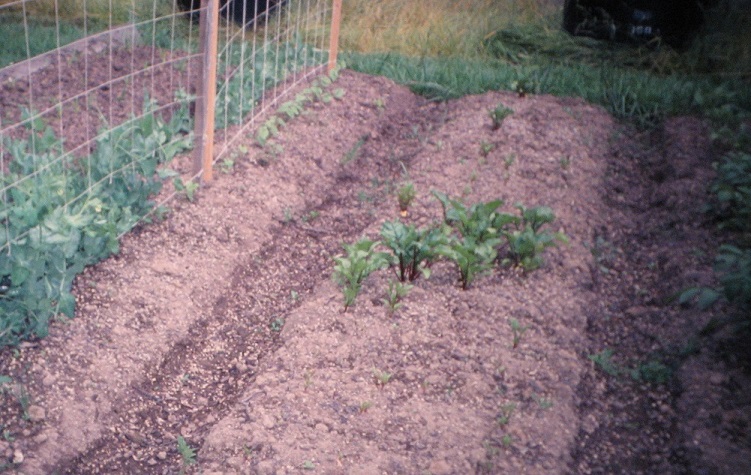
Raised Bed With Trenches Every Five Feet
A great deal of satisfaction comes from growing fresh garden vegetables. The freshest, tastiest and most nutritious produce comes to the table direct from the garden. Also, the gardener can control what pesticides have been used on the food.
Choose a site that gets at least eight hours of direct sunlight, although peas and potatoes will grow with only six hours of sun. Lettuce is less likely to bolt, that is, go to seed, if it is shaded during hot afternoons, but tomatoes need full sun in late afternoon. Avoid steep slopes that will erode, or low, soggy ground. A slight slope improves drainage. The traditional garden is a square or rectangle with dimensions of ten to thirty feet. However, vegetables can be grown in beds and borders along with ornamentals. I grew peas and pole beans in a two feet wide border along the back fence. The fence supported the string trellis for the peas and pole beans.
The most important part of successful gardening is to properly prepare the soil. An ideal garden soil would contain about 40% silt, 30% sand, 20% clay and 10% organic matter to improve aeration and drainage as well as to hold nutrients until plants can use them. Clay soils are fairly rich in nutrients but very poor in aeration and drainage. Add sandy loam soil and compost to clay soils to help plants grow better. Sawdust, barkdust, manure and compost are all good sources of organic matter, but extra nitrogen will have to be added to fresh sawdust or barkdust.
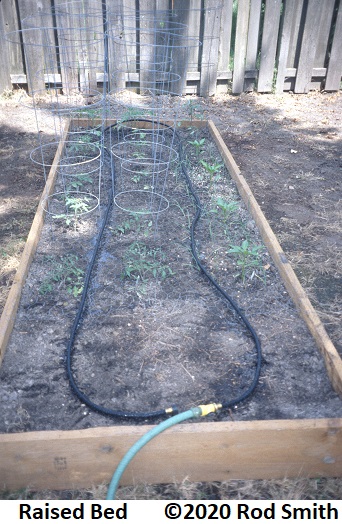
To prepare the soil, first wait until the soil is ready to work. If the soil is too wet, clay will pack into hard clods. To check the soil, squeeze a handful into a ball, then press on it. If it crumbles, the soil is ready. If the soil dents like modeling clay, it is too wet to till. If the soil is too dry, it will shatter into dust, then turn to mud when it is watered. Water dry soil and let it soak in for a day or two. Then spread the required soil amendments over the soil. I recommend two inches of sandy loam and two or three inches of compost. Also, spread ten pounds of a 10-10-10 fertilizer and three pounds of prilled lime for every 100 square feet of garden. Do not till the soil into dust, but leave marble to golf ball sized lumps. For more information, see the webpage Improving Soil.
Raised beds provide better drainage and aeration. They also reduce bending and stretching, and help stop little feet from trampling and packing the soil. The beds should be narrow enough so the center can be reached from the walkways. A four feet wide bed with a one foot wide walkway works well. For raised beds without boards, I dig a walkway with a square point shovel every five feet and mound up the soil in the four foot wide beds in between. Even better, build four foot wide beds with 2X12's, and make the walkways wide enough for a mower. Make sure the wood preservative used is non-toxic. Do not use railroad ties. Raised beds can be built even taller, so the garden can be tended from a wheelchair.

Raised Bed With Trenches Every Five Feet
Be sure to use fresh seed from a reputable company. Two year old seed often does not germinate well, although tomato seed is good for ten years. Some seeds have very particular requirements to grow, so read and follow the directions carefully. For example, carrot seeds must be planted no more than 1/8" deep so that they will receive orange light in order to germinate. Seeds require that the soil be above 40 degrees for them to germinate. Warm soil seeds require that the soil be above 60 degrees. Seeds that require warm soil and a long growing season, such as tomatoes, peppers and squash, are usually started indoors and transplanted outdoors when the soil is warm. Use peat pellets or peat pots with seed starting mix and start the seeds about six weeks before they are to be planted outdoors.
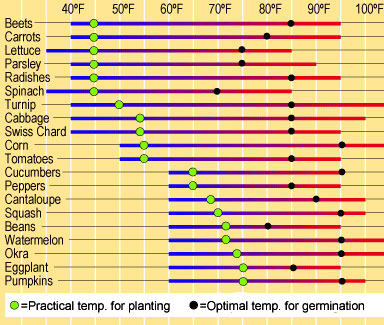
Vegetables are often grown in rows. This makes it easier to hoe weeds. However, a small area can be used much more efficiently if plants are planted in groups. I plant bush green beans in six inch squares and beets in 3 inch squares. Some hand weeding is needed when the plants are small, but when the plants are large enough to cover the ground, weeds will be crowded out.
Fast maturing plants, such as radishes, can be planted in between slower crops. Early vegetables, such as peas and radishes, can be followed by later vegetables. Planting bush green beans every two weeks provides a continuous harvest. Some vegetables can be planted in late summer for a fall crop, such as, beets, broccoli, Brussels sprouts, cabbage, carrots, cauliflower, garlic, kale, lettuce, onions, peas and spinach.
 It is important to plant seeds at the proper depth. Carrot seeds will not grow if they are too deep to receive orange light. If there are no planting directions, a rule of thumb is to plant the seed as deep as twice its length. Tiny seeds can be spread on the surface of the soil and covered with soil. Spreading newspaper over the seeded soil keeps it moist until the seeds sprout. Lima beans need to be planted with the concave side of the bean up. Larger seeds can be spaced out and pushed to the right depth with a finger. A 3/4" inch wide tape measure is a better planting guide than stretching a string.
It is important to plant seeds at the proper depth. Carrot seeds will not grow if they are too deep to receive orange light. If there are no planting directions, a rule of thumb is to plant the seed as deep as twice its length. Tiny seeds can be spread on the surface of the soil and covered with soil. Spreading newspaper over the seeded soil keeps it moist until the seeds sprout. Lima beans need to be planted with the concave side of the bean up. Larger seeds can be spaced out and pushed to the right depth with a finger. A 3/4" inch wide tape measure is a better planting guide than stretching a string.
Seed packages recommend that extra seeds be planted since not all will come up. Also, beet seeds come in clusters. After the seeds sprout, the weaker seedlings should be pinched off to give the rest enough room to grow. Some crops, such as beets, carrots and onions, can be partially harvested early to give the remaining ones more room to grow.
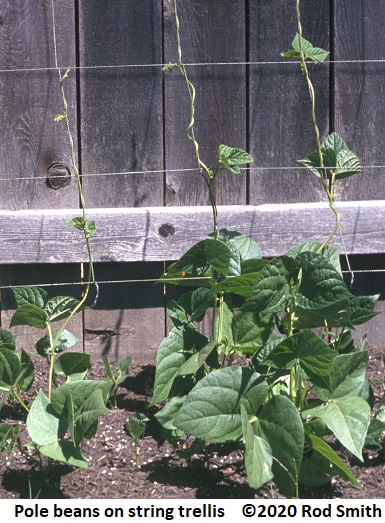
Vegetables need a constant supply of water. Water stress causes hard cored carrots and bitter lettuce. Studies have shown that, on sandy well drained soils, production is almost doubled if plants have an even supply of water. However, roots will grow deeper in clay soil if the soil is thoroughly soaked, then allowed to dry out somewhat between waterings. This helps the soil breathe deeper, and helps avoid root rot. But, letting soil get very dry, then watering heavily, will cause tomatoes to crack.
The best time to water is in the morning so plant leaves dry off quickly. Never water late in the evening so leaves are wet overnight. A few plants, such as tomatoes, will get burned if water drops stand on the leaves in hot sun. However, cool season plants will benefit from a cooling spray on hot afternoons. The most efficient watering system is drip irrigation. It puts the water directly in the soil where it is needed and keeps the tops dry so there are less disease problems. There are also water timers available to take care of watering automatically.
Many insects attack vegetables. Physical barriers, such as garden blankets, exclude insects from the garden. Traps, such as yellow sticky traps, reveal how many and what types of insects are present. Biological controls, such as ladybugs, B.T. and marigolds, are natural insect controls. Horticultural oil, neem oil, pyrethrin and spinosad are natural insecticides. Malathion and Sevin are synthetic insecticides that can be used on vegetables. Read and follow the directions carefully. Observe that some products should not be used within so many days of harvest.
Diseases may be caused by bacteria, fungi or viruses. Early blight is a common bacterial disease. Powdery mildew and leaf spots are common fungal diseases. Tomato curly top is a common viral disease. Copper sulfate is effective against both bacterial and fungal diseases. Daconil, Funginex and benomyl are good fungicides. Sulfur and neem oil are two natural fungicides. There are no chemical treatments for viral diseases, so diseased plants should be removed before insects spread the virus. Disease controls need to be applied before diseases appear. The best disease control for most leaf spot diseases is to keep the leaves dry. Picking green beans when they are wet is likely to spread bacterial bean blight.
Thoroughly cleaning up leftover vegetables and rotating each vegetable to a different part of the garden each year will reduce insect and disease problems. Vegetable garden photos become a guide to planting the following year so vegetables are rotated. The Oregon State University Extension Office maintains a website which describes plant disease control methods for most agricultural and ornamental plants. The index is found at Plant Disease.
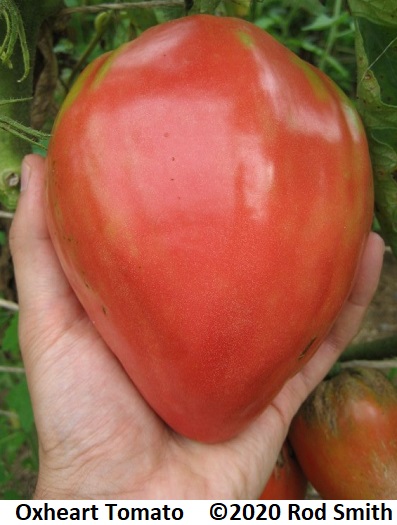
Weeds can be controlled by a layer of newspaper or mulch, by weed barrier, or by Dacthal Weed Preventer. There will still be some hand weeding and hoeing to do. There are several styles of hoes that cut the weeds off below the soil line and do not disturb the weed killer on the surface. I prefer the Ames Action Hoe which has a blade shaped like a stirrup. Weeds are also controlled by planting vegetables close enough that the soil surface is covered.
More information on controlling insects, diseases and weeds can be found in the webpage on Pest Control.
To get the biggest harvest and best flavor, vegetables should be picked at their peak of maturity. Vegetables that are the fruit of the plant, such as beans, peas, peppers, tomatoes and zucchini, should be picked every two or three days to get them when they are first ripe. Melons and squash are ripe when the underside is yellow. Overripe vegetables should be removed so growth goes into the developing vegetables.
Vegetables that are leaves, stems or roots, such as cabbages, onions and beets, can usually be harvested over a long period as they are needed. Onions and Potatoes need to be dug before heavy fall rains begin, but beets and carrots can be left in the garden all winter for delayed harvesting. Onions too small to harvest can be replanted and will get a head start on next year, but beets and carrots need to be harvested before spring or they will be tough.
Most vegetables will store longer if kept in a refrigerator, but potatoes get watery in the refrigerator. Potatoes, pumpkins and squash store well at room temperature. Store them on cardboard or wood because pumpkins sitting on cement will rot.
Edible Landscaping
Fruit Tree Tips
Herbs for the Kitchen and Landscape
Pest Control
No One Wins an Argument